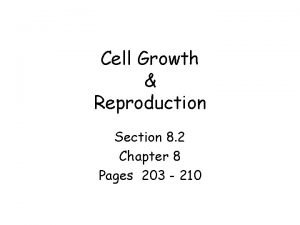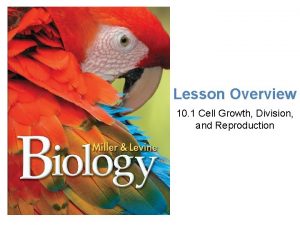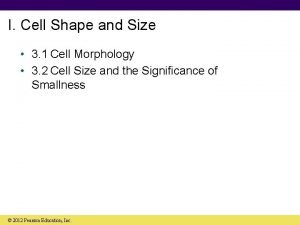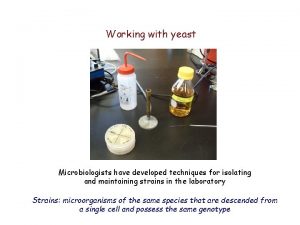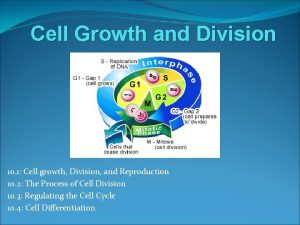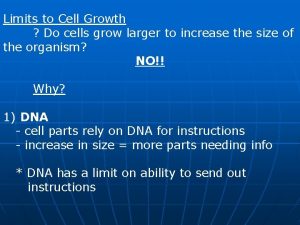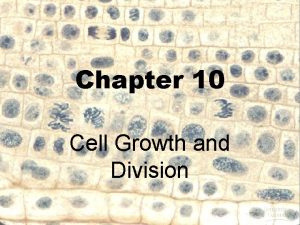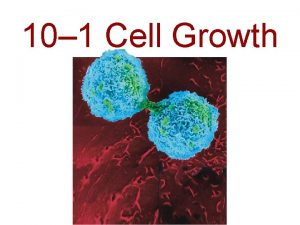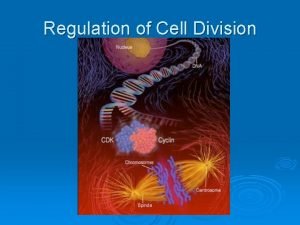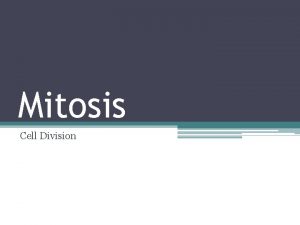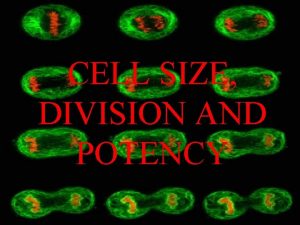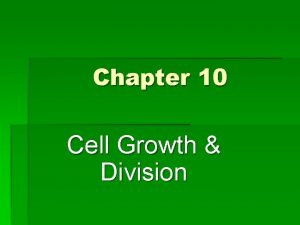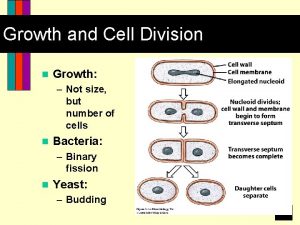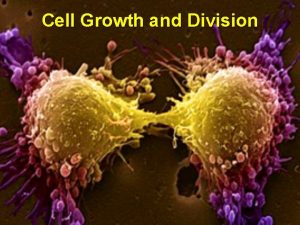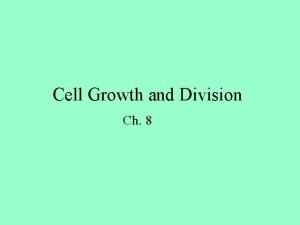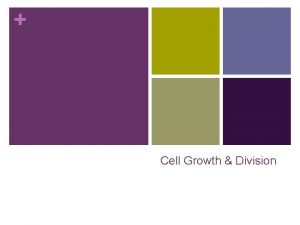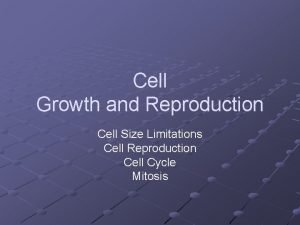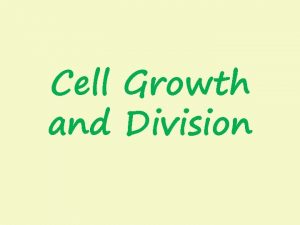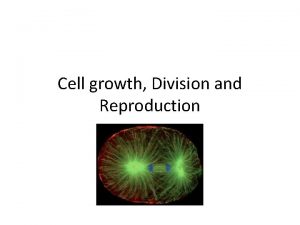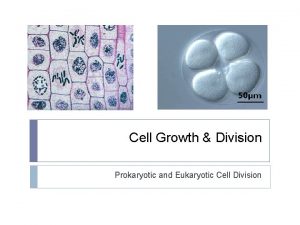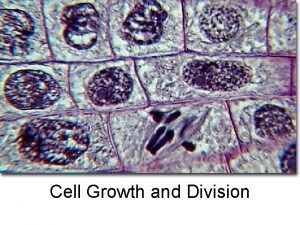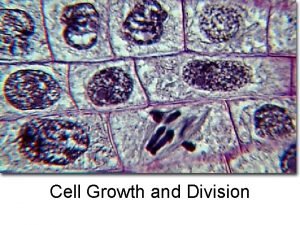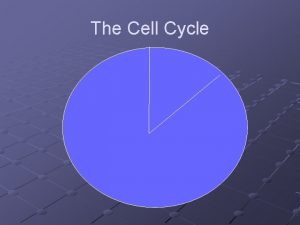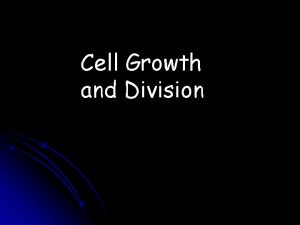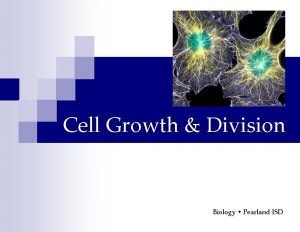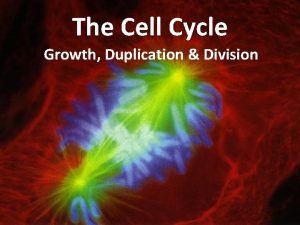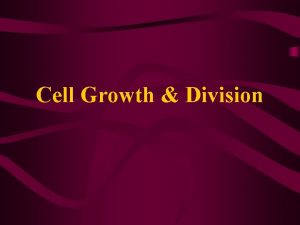Cell Growth and Division Ch 10 Cell Size































- Slides: 31

Cell Growth and Division Ch. 10

Cell Size and Limitation • Cells come in a variety • What is diffusion? of sizes. – Diffusion limits cell size – DNA content limits size

Diffusion and DNA limit cell size because… • Cells rely on diffusion to carry on proper functions – Cells require a constant supply of glucose and oxygen – Cells must constantly get rid of waste. • DNA is found in all cells. – The larger the cell, the greater number of enzymes – DNA makes enzymes needed for the cell

Is bigger better? • Surface Area to Volume Ratio – As the cell size increases, its volume increases 2 x faster…. why is this a problem? Other ways to solve the problem • If cell size doubled, it would be an 8 fold increase in volume, but the surface area would only increase 4 fold. Therefore, there is not enough membrane for nutrients to flow through to keep the cell alive.

How do cells overcome this problem? • What do you think? – How will you get more membrane to compensate for the volume? • They divide into 2 cells allowing for twice as much membrane to be formed. 1. 7 a Cell growth and division are caused by complex interactions between the different kinds of molecules in the cell.

3 purposes of cell division 1. Growth • 1. 8 a All growth and development within a 2. Repair cell is a consequence 3. Reproduction of an increase in cell a. Asexual- offspring number, size and/or produced only by one products. parent. (bacteria) Not much variation. b. Sexual- produces offspring that have a combination of genetic material from two parent organisms. Lots of variation.

Rate of Cell Division • The Pituitary gland secretes a growth hormone that tells cells when to divide and how much. If you lack this hormone, dwarfism may occur. 1. 7 b Molecules from different parts of the cells, such as hormones, can affect cell behavior.

Structure of eukaryotic chromosomes • Before cell division, each chromosome is replicated. • Each chromosome consists of 2 identical sister chromatids. • Each sister chromatid will separate from each other during cell division and go into its new cell. • When chromatin coils it becomes _______?

1. 1 a All of the cells in your body come from a single cell that differentiates into many different cells, but they all essentially have the same genetic instructions. S IO ME MIT OSIS • 1. 11 All organisms begin their life cycles as a single cell, and in multicellular organisms, new generations of embryonic cells form by cell division.

1. 8 b Cells differentiate from each other because of gene expression and/or environmental influences. • Certain genes can be turned off or on at certain time. (Expresses or not expressed). • The environment can influence what cells are expressed or not. This also causes cells to differentiate.

The Cell Cycle • The cell cycle is the repeated sequence of cell growth (interphase) followed by cell division (mitosis) • 5 phases – – – Interphase Prophase Metaphase Anaphase Telophase Mitosis- process of nuclear division followed by cytoplasmic division.


Interphase…a busy time (90% of cell cycle) • Cell activities during interphase: – – – – – Make ATP Repairing themselves Excreting wastes Making proteins Producing new organelles Duplicating DNA Chromatin duplicates Metabolism Cell growth in size • 3 phases: – G 1: normal growth phase (9 hours) – S: DNA is replicating (10 hours) – G 2: final growth in preparation for mitosis (2 hours)

Structure of the Chromosome • Each chromosome has two identical partssister chromatids that are held together by a centromere.

Other structures used. . • Centrioles are a pair of cylindrical structures made of microtubules that are only found in animal cells and found just outside the nucleus. • Spindles are cagelike structures that are made of microtubules and used to separate sister chromatids. • Spindle fibers are the individual microtubules of the spindle.

Prophase- the first phase • Chromatin coils and becomes chromosomes. • The nucleus disappears. • Centrioles migrate to opposite poles of the cell. • The spindle forms and attaches to the centrioles and centromere.


Metaphase- the • Chromosomes line up along the equator • Spindle fibers attach to the centromeres. nd 2 phase


Anaphase- the • Sister chromatids separate and centromeres split apart. rd 3 phase


Telophase- the • The “reverse” of prophase – Chromosomes uncoil to make chromatin – Spindle fibers disappear – Nucleus forms – Plasma membrane begins to from between 2 nuclei. th 4 phase

The final step • Cytokinesis- the division of the cytoplasm that results in two new daughter cells. • In plants, a cell plate forms across the equator, so the membrane doesn’t have to pinch in. • ** Centrioles are not found in plant cells during cell division. Mitosis in motion

The result • Each new daughter cell will have complete set of genetic material.

Cell Cycle Regulators • Cyclins are proteins that regulate the timing of the cell cycle in eukaryotic cells. • Internal Regulators- proteins that respond to events inside the cell. Allow cell cycle to proceed only when certain processes have happened. • External Regulators- direct cells to speed up or slow down cell cycle. External or Internal? – Make sure cell doesn’t enter mitosis until all its chromosomes have been replicated. – Growth factors. – Prevents cell from entering anaphase until all of its chromosomes are attached to mitotic spindle.

Enzymes control the cell • Some control progression from one phase to another. • Come inhibit progression. • If too much or not enough is produced it can lead to cell death or cancer. • Genes control enzyme production. • Contact inhibition is another way the cell cycle is controlled. Cells normally stop dividing when they come into contact with each other. 1. 7 a Cell growth and division are caused by complex interactions between the different kinds of molecules in the cell.

Cancer. . A Mistake in the Cycle • Cancer is thought to be due to changes in genes that make enzymes involved in the cell cycle. • Cells divide when they shouldn’t. • Cancer cells do not respond to the signals that regulate the growth of most cells. • Cancer cells can break away from a tumor (large mass) and travel through the blood to other areas in the body. • Gene p 53 normally stops the cell cycle until all chromosomes have been replicated, but if there is a defect, growth is not controlled.

Other causes of cancer • • Cigarette smoke Air and water pollution UV radiation Certain viruses – Cervical cancer -HPV – Mesothemioma – Liver cancer- Hep B • Some people may be born with genetic mistakes which may cause cancer. – Gene p 53. • Cancer is the 2 nd leading cause of death in the U. S. Heart disease is #1.

Stem Cells • Stem cells are unspecialized • Neurons are noncells that have the potential to replaceable. differentiate to become specialized in structure and • Embryonic stem cell function into a wide variety of research is very cell types. controversial because the • In early embryonic development, cells are taken from a stem cells produce every type of human embryo. tissue in the body. • Transplants fail- different • Stem cells in bone marrow can genetic info. make more than a dozen types of blood cells.

3 kinds of stem cells 1. Totiopotent- the egg and the cells that result from early cell division. Human fertilized egg has the potential to form a whole organism. 2. Pluripotent- forms five days after fertlization (blastocyst- outer layer of cells and inner cell mass). Inner cells form tissue of human. 3. Mulitpotent- pluripotent cells specialize further to give rise to specialized cells. Present in adults. Which type of cells do you think are used for medical therapies? Why? Pluripotent

Cell Cycle Review • Click on the following link, then click on your book and go to Ch. 10 and take the Self-Test and do the Active Art. • Ch. 10 Review
 Chapter 8 cell growth and division section 8-2 answer key
Chapter 8 cell growth and division section 8-2 answer key Cell growth division and reproduction
Cell growth division and reproduction Section 10-2 cell division
Section 10-2 cell division Cell cycle and cell division
Cell cycle and cell division Phases of cell cycle
Phases of cell cycle Relative growth rates
Relative growth rates Ground tissue
Ground tissue Primary growth and secondary growth in plants
Primary growth and secondary growth in plants Chapter 35 plant structure growth and development
Chapter 35 plant structure growth and development Short division vs long division
Short division vs long division Long division method
Long division method How to use synthetic division
How to use synthetic division Synthetic division steps
Synthetic division steps Growthchain
Growthchain Geometric vs exponential growth
Geometric vs exponential growth Neoclassical growth theory vs. endogenous growth theory
Neoclassical growth theory vs. endogenous growth theory Organic vs inorganic growth
Organic vs inorganic growth Const char * vs char * const
Const char * vs char * const Moderately fine powder
Moderately fine powder Mitosis meiosis
Mitosis meiosis Unit 7 cell division and heredity
Unit 7 cell division and heredity Mitosis
Mitosis Cell shape and size
Cell shape and size Yeast cell growth curve
Yeast cell growth curve 10-1 cell growth
10-1 cell growth Limits to cell growth
Limits to cell growth Section 10-1 cell growth
Section 10-1 cell growth Limits to cell growth
Limits to cell growth Pmat
Pmat Frequency of cell division
Frequency of cell division Complete the concept map of mitosis and meiosis
Complete the concept map of mitosis and meiosis Interphase of cell cycle
Interphase of cell cycle
